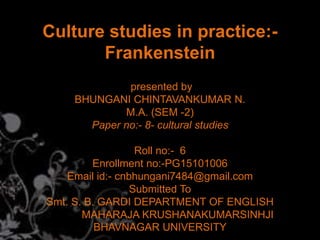
paper no.8:- culture studies in practice:-Frankenstein
- 1. Culture studies in practice:- Frankenstein presented by BHUNGANI CHINTAVANKUMAR N. M.A. (SEM -2) Paper no:- 8- cultural studies Roll no:- 6 Enrollment no:-PG15101006 Email id:- cnbhungani7484@gmail.com Submitted To Smt. S. B. GARDI DEPARTMENT OF ENGLISH MAHARAJA KRUSHANAKUMARSINHJI BHAVNAGAR UNIVERSITY
- 2. Mary Shelley’s Novel has morphed in to Countless Form Fiction & Non- fiction Stage Plays Film Television Advertising Comic Book Games cartoons Academic Study Food (Frankenberry)
- 3. In below given quote we can see his hunger for knowledge and to create a life through that knowledge “The world was to me a secret which I desired to divine. Curiosity earnest research to learn the hidden laws of nature, gladness akin to rapture, as they were earliest sensation I can remember” Humanity which sees the moral or ethical consent of the novel and by this I also want to prove my point that why Marry Shelley wants to create a male monster? But by this regard I can say through observing all aspect the aspects of novel and its study that I have, and naturally this clear when its shows the power of men and in other hand the ugliness of the monster that she wants to show and also we can say in cultural studies of this novel that, “A message on the Irony and Danger in the Quest for power” cause the generation is what that creates or challenge.
- 4. Age of Revolution Modern Consumer culture Frankenstein is “a vital metaphor, peculiarly appropriate to CULTURE dominated by a consumer technology, neurotically obsessed with ‘getting in touch’ with its authentic self and frightened at what it is discovering. - George Levine From CNN descriptions of Saddam Hussein as an “American Created Frankenstein” to magazine articles that warn of genetically engineered “Franken-foods,” test-tube babies, and cloning.
- 5. Monster like the creature Paradoxical Transgress against “establishment” Destroy monster by society Mary Shelley’s Creature is Political and Moral paradox
- 6. Creature as Proletarian Percy Shelley was thought of as a dangerous radical bent on labor reform and was spied upon by the government. In Frankenstein, what Johanna M. Smith calls the “ alternation between fear of vengeful revolution and sympathy for the suffering poor.” illuminates Mary Shelley’s own divisions between fear of the masses.
- 7. From Natural Philosophy to Cyber: • Today, in 21 century an age of genetic engineering, biotechnology, and cloning, the most far-reaching industrialization of life forms to date, Frankenstein is more relevant than ever. • Result of genetic engineering is that like…. surrogate mother, test- tube baby, Cloning,
- 8. A Race of Devils Frankenstein may analyzed in its portrayal of different “Races”. Mary Shelley’s creature’s skin is only described ‘YELLOW’. It has been constructed “out of a cultural tradition of the threatening ‘Other’- whether troll or giant,gypsy or Negro from the dark inner recesses of Xenophobic fear and loathing. • - H.L. Malchow
- 9. The Frankenpheme in Popular Culture: • Fiction,Drama,Film,Television ,games,comic book ,magazine, act… • Cultural sign in Frankenstein made to be a Frankentheme and the heart of the novel irony. How the Victor creates a way of live, and how the Frankenstein throws any as a orphan and suffering from society’s cruelness. Even Victor’s reliance upon defensive idealization represents one the major narcissistic feature of his. He repeatedly makes one statement about his childhood that; • “No human being could have childhood passed a happier than me”
- 11. The First Theatrical Presentation based on Frankenstein was Presumption or The Fate of Frankenstein by Richard Brinsley Peake, Performed at the English Opera House in London in the Summer of 1823. In Drama Creature has generally been made Horrific, and Victor has been assigned less blame. On 19th Century Stage, the Creature was a composite of frightening makeup and human qualities.
- 12. Films In Frankenstein Omnibus, reader can study the screenplay for the 1931 by James Whale film Frankenstein, the most famous of all adaption.
- 13. Conclusion • Mary Shelley’s Sci-Fi adventure, thriller and dramatize the novel in that one can do the thing which challenging the God’s creation, the cultural sign and its major aspects. In this novel we come across with mythical story or we can say culture tale like “Prometheus”, “Narcissus” and “Paradise lost”. Mary Shelley has presented very fruitfully and with appropriate facts. Her novel has morphed into countless forms in both height brow and popular culture. Her creation teaches us not to underestimate the power of youth culture. It is truly captivating powerful novel that analyzes ‘Monstrosity’ with regard to ‘humanity’. However without a sound understanding of the context, in which the text was written one couldn’t completely comprehend the themes, ideas and references did not present nor can the apparent link between monstrosity and humanity be completely